Hollow Microcavity Electrode for Enhancing Light Extraction
Abstract
1. Introduction
2. Materials and Methods
2.1. Laser Interference Lithography
2.2. Fabrication of a Nanoscale Vacuum Photonic Crystal Layer
2.3. Nanophotonic Computational Analysis
2.4. Device Fabrication
2.5. Measurements
3. Results and Discussion
3.1. Design and Fabrication of the Hollow Microcavity Electrode
3.2. FDTD Simulation for Bragg Diffraction and the Microcavity Effect
3.3. Analysis of the nVPCL-Integrated Electrode
3.4. Device Application
4. Conclusions
5. Patents
Supplementary Materials
Author Contributions
Funding
Data Availability Statement
Acknowledgments
Conflicts of Interest
References
- Leung, S.F.; Zhang, Q.P.; Xiu, F.; Yu, D.L.; Ho, J.C.; Li, D.D.; Fan, Z.Y. Light management with nanostructures for optoelectronic devices. J. Phys. Chem. Lett. 2014, 5, 1479–1495. [Google Scholar] [CrossRef]
- Choy, W.C.H.; Chan, W.K.; Yuan, Y.P. Recent advances in transition metal complexes and light-management engineering in organic optoelectronic devices. Adv. Mater. 2014, 26, 5368–5399. [Google Scholar] [CrossRef] [PubMed]
- Wang, X.T.; Cui, Y.; Li, T.; Lei, M.; Li, J.B.; Wei, Z.M. Recent advances in the functional 2D photonic and optoelectronic devices. Adv. Opt. Mater. 2019, 7, 1801274. [Google Scholar] [CrossRef]
- Cao, W.; Li, J.; Chen, H.; Xue, J. Transparent electrodes for organic optoelectronic devices: A review. J. Photon. Energy 2014, 4, 040990. [Google Scholar] [CrossRef]
- Chen, H.W.; Lee, J.H.; Lin, B.Y.; Chen, S.; Wu, S.T. Liquid crystal display and organic light-emitting diode display: Present status and future perspectives. Light Sci. Appl. 2017, 7, 17168. [Google Scholar] [CrossRef]
- Wei, Q.; Fei, N.N.; Islam, A.; Lei, T.; Hong, L.; Peng, R.X.; Fan, X.; Chen, L.; Gao, P.Q.; Ge, Z.Y. Small-molecule emitters with high quantum efficiency: Mechanisms, structures, and applications in OLED devices. Adv. Opt. Mater. 2018, 6, 1800512. [Google Scholar] [CrossRef]
- Salehi, A.; Fu, X.Y.; Shin, D.H.; So, F. Recent advances in OLED optical design. Adv. Funct. Mater. 2019, 29, 1808803. [Google Scholar] [CrossRef]
- Meerheim, R.; Furno, M.; Hofmann, S.; Lüssem, B.; Leo, K. Quantification of energy loss mechanisms in organic light-emitting diodes. Appl. Phys. Lett. 2010, 97, 253305. [Google Scholar] [CrossRef]
- Gather, M.C.; Reineke, S. Recent advances in light outcoupling from white organic light-emitting diodes. J. Photon. Energy 2015, 5, 057607. [Google Scholar] [CrossRef]
- Forrest, S.R.; Bradley, D.D.C.; Thompson, M.E. Measuring the efficiency of organic light-emitting devices. Adv. Mater. 2003, 15, 1043–1048. [Google Scholar] [CrossRef]
- Baldo, M.A.; Lamansky, S.; Burrows, P.E.; Thompson, M.E.; Forrest, S.R. Very high-efficiency green organic light-emitting devices based on electrophosphorescence. Appl. Phys. Lett. 1999, 75, 4–6. [Google Scholar] [CrossRef]
- Fukagawa, H.; Shimizu, T.; Kamada, T.; Yui, S.; Hasegawa, M.; Morii, K.; Yamamoto, T. Highly efficient and stable organic light-emitting diodes with a greatly reduced amount of phosphorescent emitter. Sci. Rep. 2015, 5, 9855. [Google Scholar] [CrossRef]
- Zhao, J.; Chen, X.J.; Yang, Z.; Liu, T.T.; Yang, Z.Y.; Zhang, Y.; Xu, J.R.; Chi, Z.G. Highly-efficient doped and nondoped organic light-emitting diodes with external quantum efficiencies over 20% from a multifunctional green thermally activated delayed fluorescence emitter. J. Phys. Chem. C 2019, 123, 1015–1020. [Google Scholar] [CrossRef]
- Kaji, H.; Suzuki, H.; Fukushima, T.; Shizu, K.; Suzuki, K.; Kubo, S.; Komino, T.; Oiwa, H.; Suzuki, F.; Wakamiya, A.; et al. Purely organic electroluminescent material realizing 100% conversion from electricity to light. Nat. Commun. 2015, 6, 8476. [Google Scholar] [CrossRef]
- Zhang, Q.S.; Tsang, D.; Kuwabara, H.; Hatae, Y.; Li, B.; Takahashi, T.; Lee, S.Y.; Yasuda, T.; Adachi, C. Nearly 100% internal quantum efficiency in undoped electroluminescent devices employing pure organic emitters. Adv. Mater. 2015, 27, 2096–2100. [Google Scholar] [CrossRef]
- Song, J.; Lee, H.; Jeong, E.G.; Choi, K.C.; Yoo, S. Organic light-emitting diodes: Pushing toward the limits and beyond. Adv. Mater. 2020, 32, 1907539. [Google Scholar] [CrossRef]
- Tyan, Y.S. Organic light-emitting-diode lighting overview. J. Photon.-Energy 2011, 1, 011009. [Google Scholar] [CrossRef]
- Davis, R.F.; Kelner, G.; Shur, M.; Palmour, J.W.; Edmond, J.A. Thin-film deposition and microelectronic and optoelectronic device fabrication and characterization in monocrystalline alpha and beta silicon-carbide. Proc. IEEE 1991, 79, 677–701. [Google Scholar] [CrossRef]
- Zhao, J.; Chi, Z.H.; Yang, Z.; Chen, X.J.; Arnold, M.S.; Zhang, Y.; Xu, J.R.; Chi, Z.G.; Aldred, M.P. Recent developments of truly stretchable thin film electronic and optoelectronic devices. Nanoscale 2018, 10, 5764–5792. [Google Scholar] [CrossRef]
- Sharma, S.; Vyas, S.; Periasamy, C.; Chakrabarti, P. Structural and optical characterization of ZnO thin films for optoelectronic device applications by RF sputtering technique. Superlattices Microstruct. 2014, 75, 378–389. [Google Scholar] [CrossRef]
- Hauss, J.; Bocksrocker, T.; Riedel, B.; Lemmer, U.; Gerken, M. On the interplay of waveguide modes and leaky modes in corrugated OLEDs. Opt. Express 2011, 19, A851–A858. [Google Scholar] [CrossRef]
- Nowy, S.; Krummacher, B.C.; Frischeisen, J.; Reinke, N.A.; Brütting, W. Light extraction and optical loss mechanisms in organic light-emitting diodes: Influence of the emitter quantum efficiency. J. Appl. Phys. 2008, 104, 123109. [Google Scholar] [CrossRef]
- Hobson, P.A.; Wasey, J.A.E.; Sage, I.; Barnes, W.L. The role of surface plasmons in organic light-emitting diodes. IEEE J. Sel. Top. Quant. 2002, 8, 378–386. [Google Scholar] [CrossRef]
- Beck, F.J.; Verhagen, E.; Mokkapati, S.; Polman, A.; Catchpole, K.R. Resonant SPP modes supported by discrete metal nanoparticles on high-index substrates. Opt. Express 2011, 19, A146–A156. [Google Scholar] [CrossRef] [PubMed]
- Barnes, W.L. Surface plasmon-polariton length scales: A route to sub-wavelength optics. J. Opt. A Pure Appl. Opt. 2006, 8, S87–S93. [Google Scholar] [CrossRef]
- Möller, S.; Forrest, S.R. Improved light out-coupling in organic light emitting diodes employing ordered microlens arrays. J Appl. Phys. 2002, 91, 3324–3327. [Google Scholar] [CrossRef]
- Lee, S.; Park, J.Y.; Park, J.; Bi, J.C.; Kang, B.; Hwang, Y.H.; Seok, J.; Park, Y.W.; Ju, B.K. Enhancement of light extraction efficiency and suppression of roll-off characteristics of thermally activated delayed fluorescence organic light-emitting diodes by inserting nanoscale pixel-defining layer. Adv. Electron. Mater. 2023, 9, 2201264. [Google Scholar] [CrossRef]
- Shin, C.; Lee, S.; Choi, K.W.; Hwang, Y.H.; Park, Y.W.; Ju, B.K. Random rubbed structure for enhanced light extraction in organic light-emitting diodes. J. Lumin. 2022, 243, 118670. [Google Scholar] [CrossRef]
- Shin, C.; Lee, S.; Choi, K.W.; Hwang, Y.H.; Park, Y.W.; Ju, B.K. Enhancing the optical performance of organic light-emitting diodes using nanoscale random rubbed structure. Nanomater. Nanotechnol. 2022, 12, 18479804221132983. [Google Scholar] [CrossRef]
- Bathelt, R.; Buchhauser, D.; Gärditz, C.; Paetzold, R.; Wellmann, P. Light extraction from OLEDs for lighting applications through light scattering. Org. Electron. 2007, 8, 293–299. [Google Scholar] [CrossRef]
- Bulovic, V.; Khalfin, V.B.; Gu, G.; Burrows, P.E.; Garbuzov, D.Z.; Forrest, S.R. Weak microcavity effects in organic light-emitting devices. Phys. Rev. B 1998, 58, 3730–3740. [Google Scholar] [CrossRef]
- Chang, C.H.; Cheng, H.C.; Lu, Y.J.; Tien, K.C.; Lin, H.W.; Lin, C.L.; Yang, C.J.; Wu, C.C. Enhancing color gamut of white OLED displays by using microcavity green pixels. Org. Electron. 2010, 11, 247–254. [Google Scholar] [CrossRef]
- Peng, H.J.; Sun, J.X.; Zhu, X.L.; Yu, X.M.; Wong, M.; Kwok, H.S. High-efficiency microcavity top-emitting organic light-emitting diodes using silver anode. Appl. Phys. Lett. 2006, 88, 073517. [Google Scholar] [CrossRef]
- Revelli, J.F.; Tutt, L.W.; Kruschwitz, B.E. Waveguide analysis of organic light-emitting diodes fabricated on surfaces with wavelength-scale periodic gratings. Appl. Opt. 2005, 44, 3224–3237. [Google Scholar] [CrossRef]
- Lim, T.B.; Cho, K.H.; Kim, Y.H.; Jeong, Y.C. Enhanced light extraction efficiency of OLEDs with quasiperiodic diffraction grating layer. Opt. Express 2016, 24, 17950–17959. [Google Scholar] [CrossRef]
- Hauss, J.; Riedel, B.; Gleiss, S.; Geyer, U.; Lemmer, U.; Gerken, M. Periodic nanostructuring for guided mode extraction in organic light-emitting diodes. J. Photon. Energy 2011, 1, 011012. [Google Scholar] [CrossRef]
- Zhmakin, A.I. Enhancement of light extraction from light emitting diodes. Phys. Rep. 2011, 498, 189–241. [Google Scholar] [CrossRef]
- Ma, M.; Mont, F.W.; Yan, X.; Cho, J.; Schubert, E.F.; Kim, G.B.; Sone, C. Effects of the refractive index of the encapsulant on the light-extraction efficiency of light-emitting diodes. Opt. Express 2011, 19, A1135–A1140. [Google Scholar] [CrossRef]
- Choi, J.; Park, C.H.; Kwack, J.H.; Lee, D.J.; Kim, J.G.; Choi, J.; Bae, B.H.; Park, S.J.; Kim, E.; Park, Y.W.; et al. Ag fiber/IZO composite electrodes: Improved chemical and thermal stability and uniform light emission in flexible organic light-emitting diodes. Sci. Rep. 2019, 9, 738. [Google Scholar] [CrossRef]
- Solak, H.H.; Dais, C.; Clube, F. Displacement Talbot lithography: A new method for high-resolution patterning of large areas. Opt. Express 2011, 19, 10686–10691. [Google Scholar] [CrossRef]
- Shi, Z.; Jefimovs, K.; Stampanoni, M.; Romano, L. High aspect ratio arrays of Si nano-pillars using displacement Talbot lithography and gas-MacEtch. Mater. Sci. Semicond. Process. 2023, 157, 107311. [Google Scholar] [CrossRef]
- Kang, K.; Lee, Y.; Kim, J.; Lee, H.; Yang, B. A Generalized Fabry-Perot formulation for optical modeling of organic light-emitting diodes considering the dipole orientation and light polarization. IEEE Photon.-J. 2016, 8, 1600519. [Google Scholar] [CrossRef]
- Liu, Z.G.; Ge, Z.C.; Chen, X.Y. Research progress on Fabry-Perot resonator antenna. J. Zhejiang Univ. A 2009, 10, 583–588. [Google Scholar] [CrossRef]
- Azrain, M.M.; Mansor, M.R.; Fadzullah, S.H.S.M.; Omar, G.; Sivakumar, D.; Lim, L.M.; Nordin, M.N.A. Analysis of mechanisms responsible for the formation of dark spots in organic light emitting diodes (OLEDs): A review. Synth. Met. 2018, 235, 160–175. [Google Scholar] [CrossRef]
- Luo, E.Z.; Heun, S.; Kennedy, M.; Wollschlager, J.; Henzler, M. Surface-roughness and conductivity of thin Ag films. Phys. Rev. B 1994, 49, 4858–4865. [Google Scholar] [CrossRef] [PubMed]
- Tang, C.W.; Vanslyke, S.A. Organic Electroluminescent Diodes. Appl. Phys. Lett. 1987, 51, 913–915. [Google Scholar] [CrossRef]
- Indluru, A.; Alford, T.L. Effect of Ag thickness on electrical transport and optical properties of indium tin oxide-Ag-indium tin oxide multilayers. J. Appl. Phys. 2009, 105, 123528. [Google Scholar] [CrossRef]
- Zhang, J.X.; Zhang, L.D.; Xu, W. Surface plasmon polaritons: Physics and applications. J. Phys. D Appl. Phys. 2012, 45, 113001. [Google Scholar] [CrossRef]
- Kang, G.; Yoo, J.; Ahn, J.; Kim, K. Transparent dielectric nanostructures for efficient light management in optoelectronic applications. Nano Today 2015, 10, 22–47. [Google Scholar] [CrossRef]
- Hecht, D.S.; Hu, L.B.; Irvin, G. Emerging transparent electrodes based on thin films of carbon nanotubes, graphene, and metallic nanostructures. Adv. Mater. 2011, 23, 1482–1513. [Google Scholar] [CrossRef]
- Ren, W.; Son, K.R.; Park, T.H.; Murugadoss, V.; Kim, T.G. Manipulation of blue TADF top-emission OLEDs by the first-order optical cavity design: Toward a highly pure blue emission and balanced charge transport. Photonics Res. 2021, 9, 1502–1512. [Google Scholar] [CrossRef]
- Lee, C.J.; Pode, R.B.; Moon, D.G.; Han, J.L.; Park, N.H.; Baik, S.H.; Ju, S.S. On the problem of microcavity effects on the top emitting OLED with semitransparent metal cathode. Phys. Status Solidi A 2004, 201, 1022–1028. [Google Scholar] [CrossRef]
- Jin, Y.; Feng, J.; Zhang, X.L.; Bi, Y.G.; Bai, Y.; Chen, L.; Lan, T.; Liu, Y.F.; Chen, Q.-D.; Sun, H.-B. Solving Efficiency–Stability Tradeoff in Top-Emitting Organic Light-Emitting Devices by Employing Periodically Corrugated Metallic Cathode. Adv. Mater. 2012, 24, 1187–1191. [Google Scholar] [CrossRef] [PubMed]
- Schwab, T.; Fuchs, C.; Scholz, R.; Li, X.; Xie, F.; Choy, W.; Leo, K.; Gather, M.C. Improved light outcoupling and mode analysis of top-emitting OLEDs on periodically corrugated substrates. Proc. SPIE 2013, 8829, 145–153. [Google Scholar] [CrossRef]
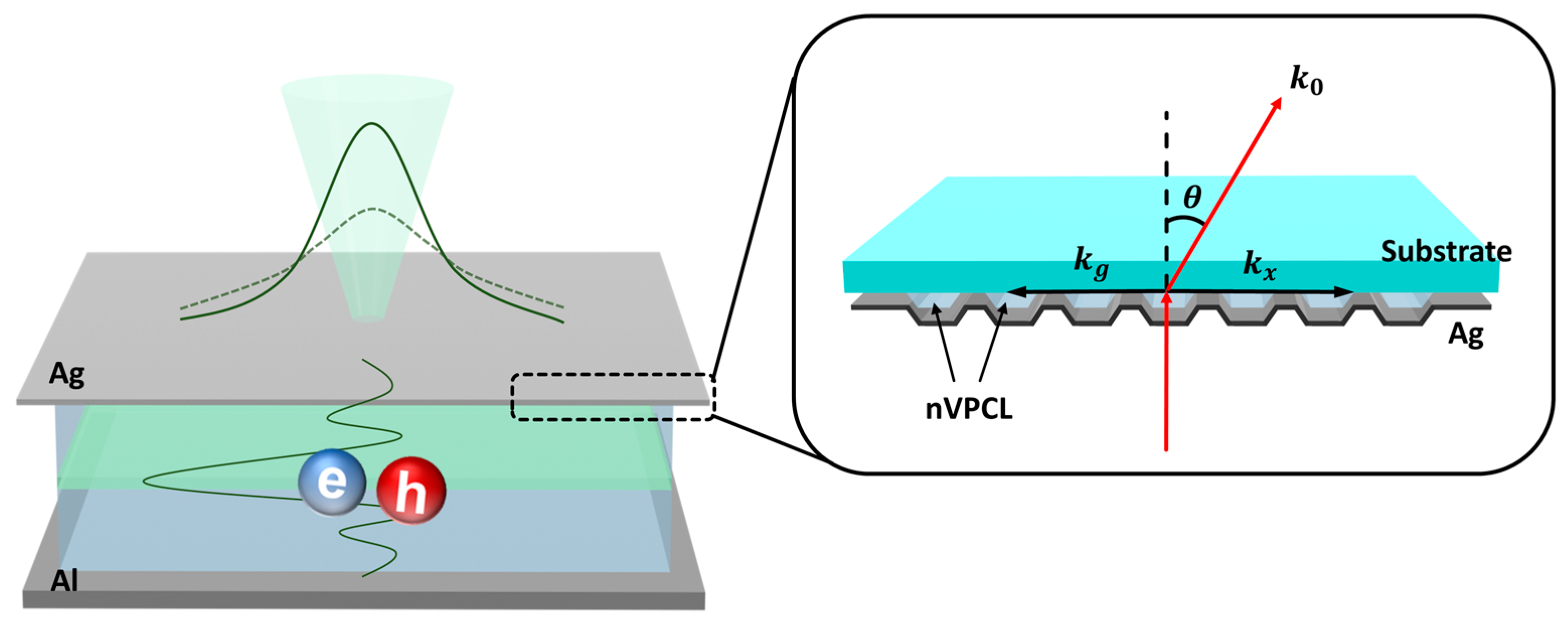
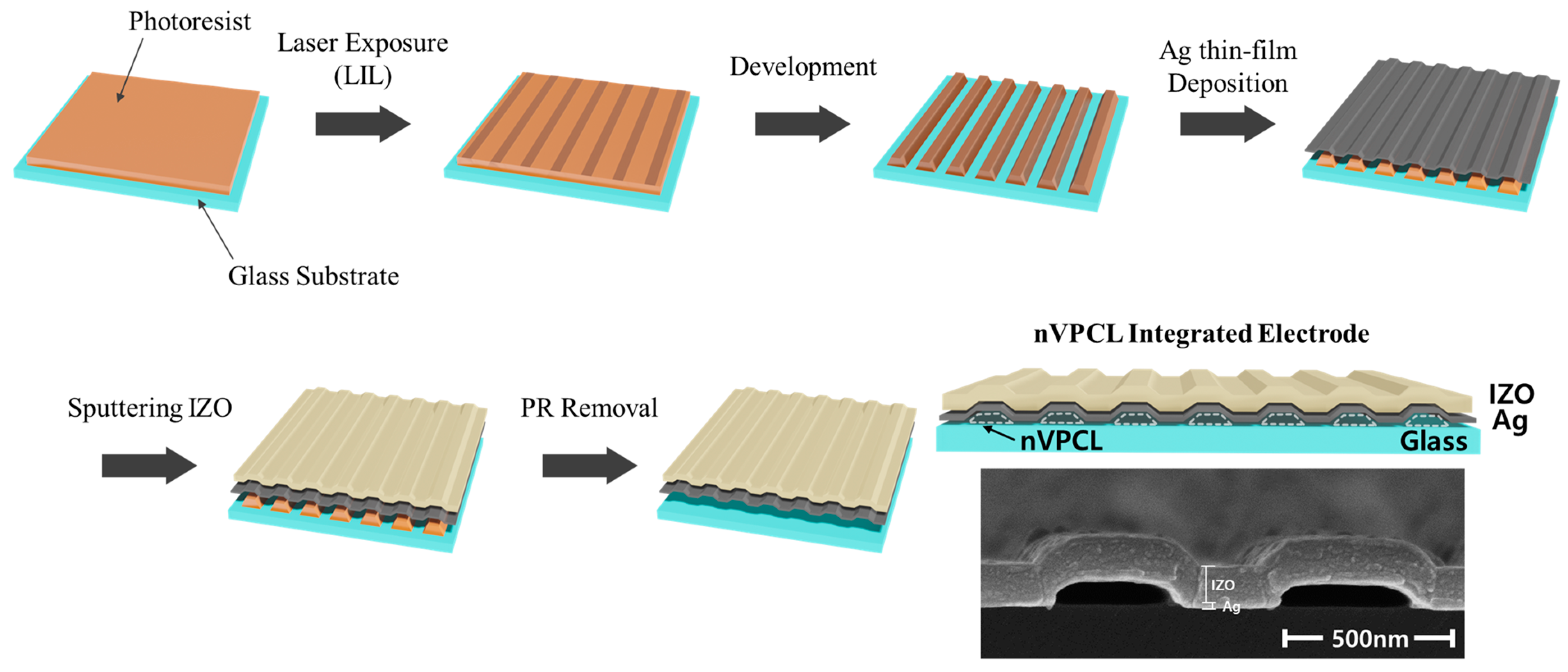
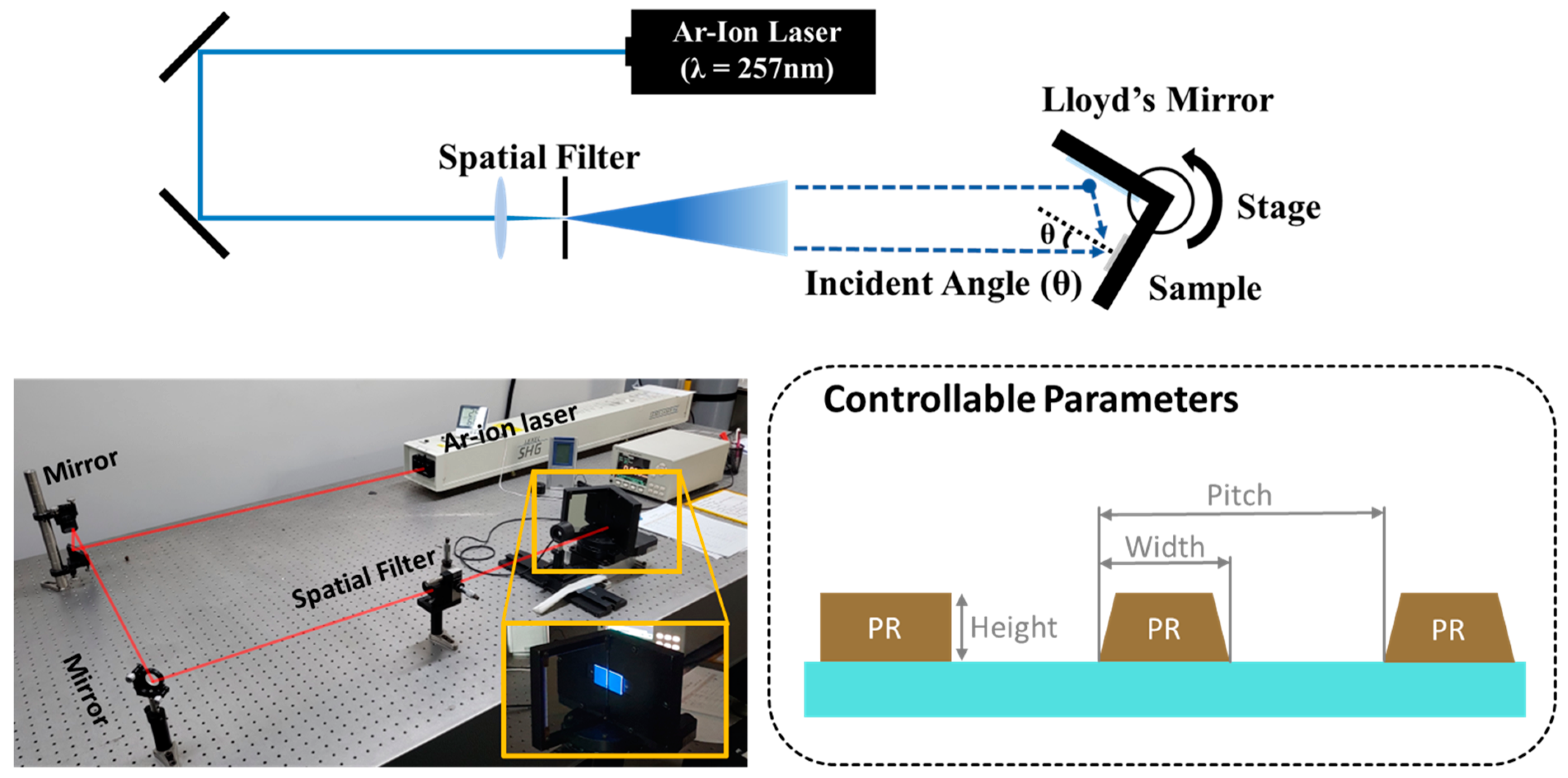


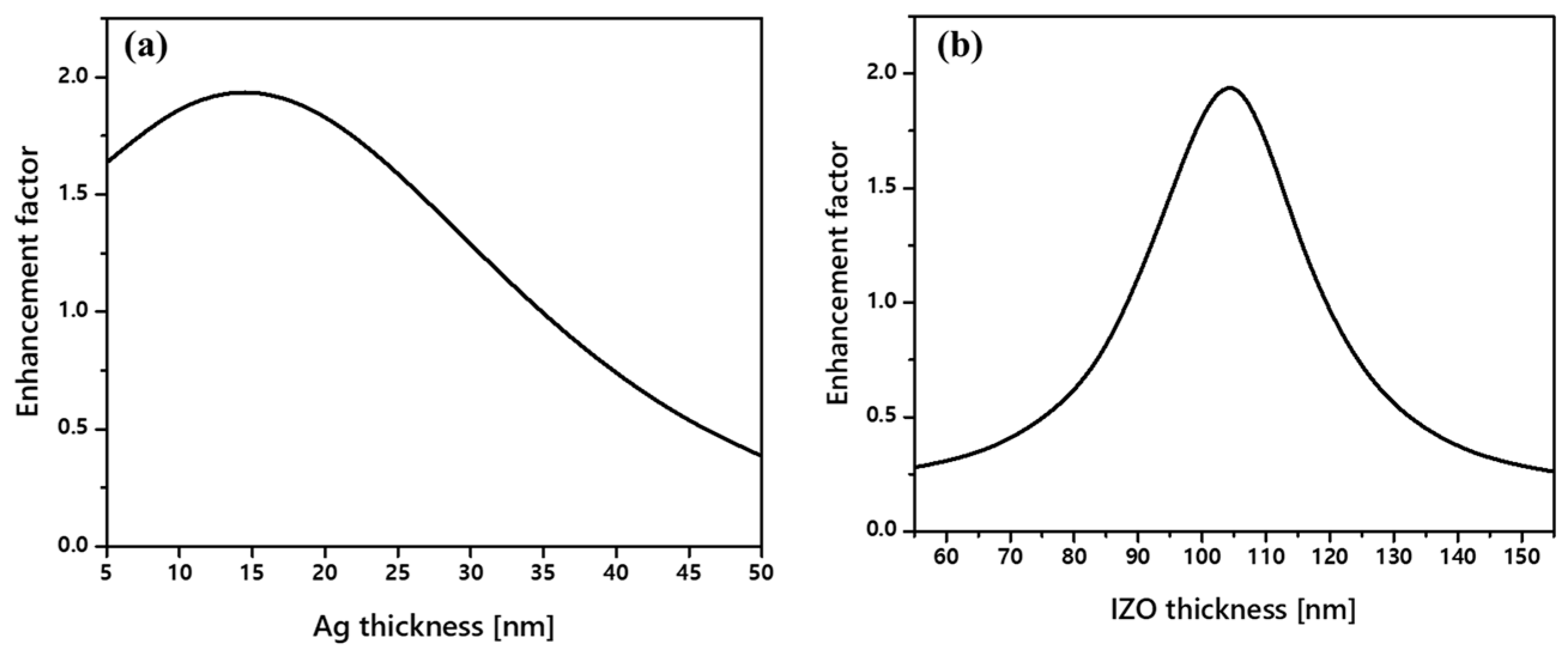
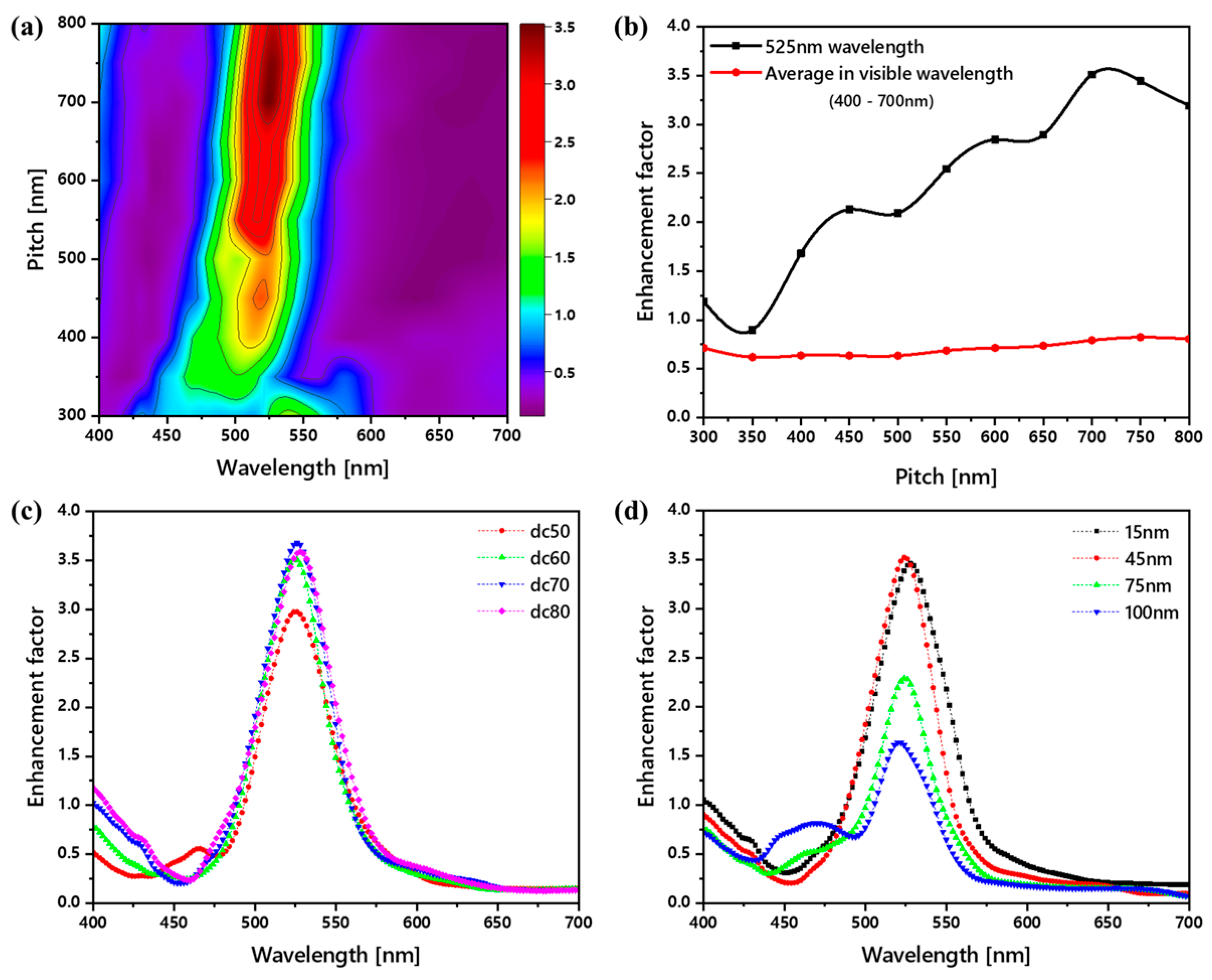
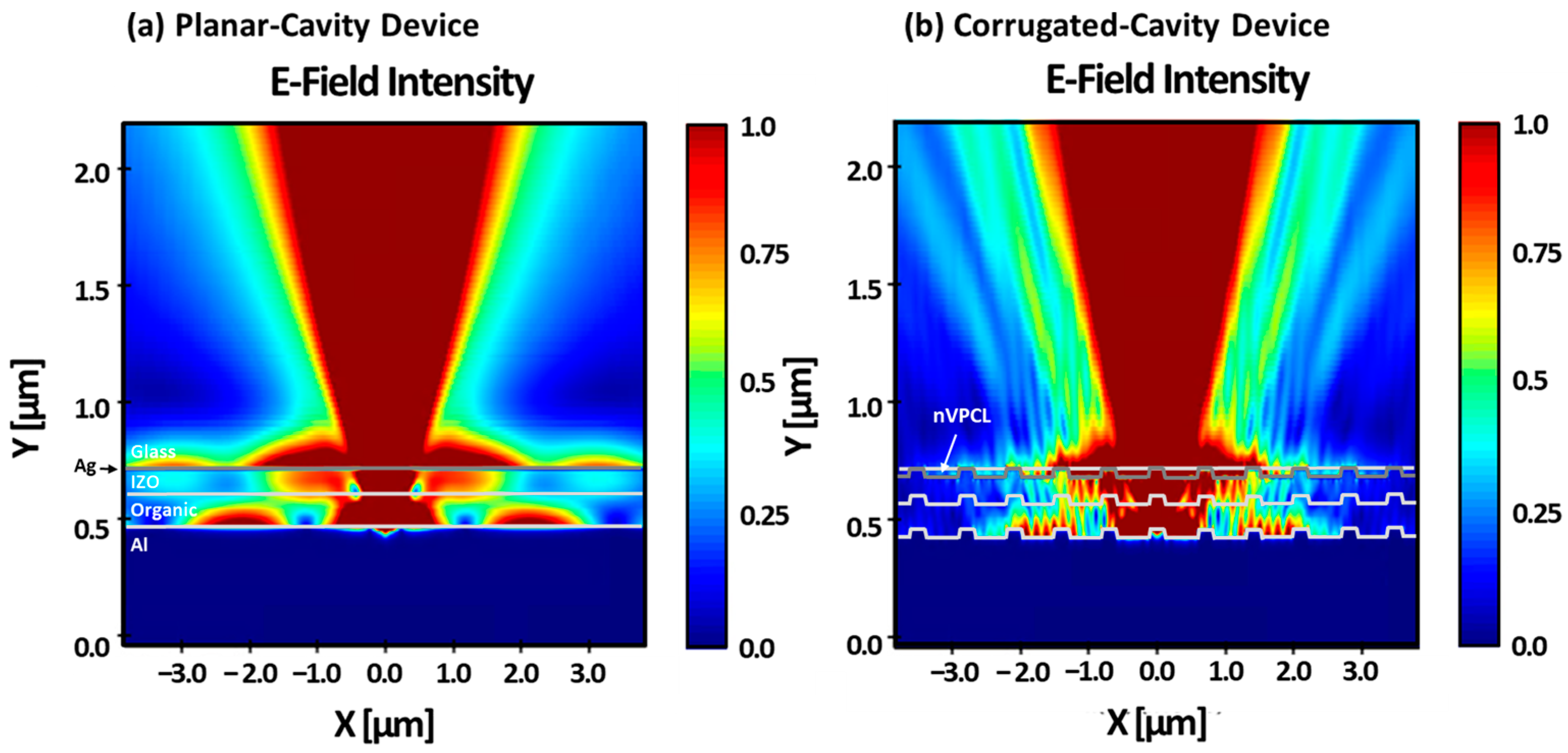

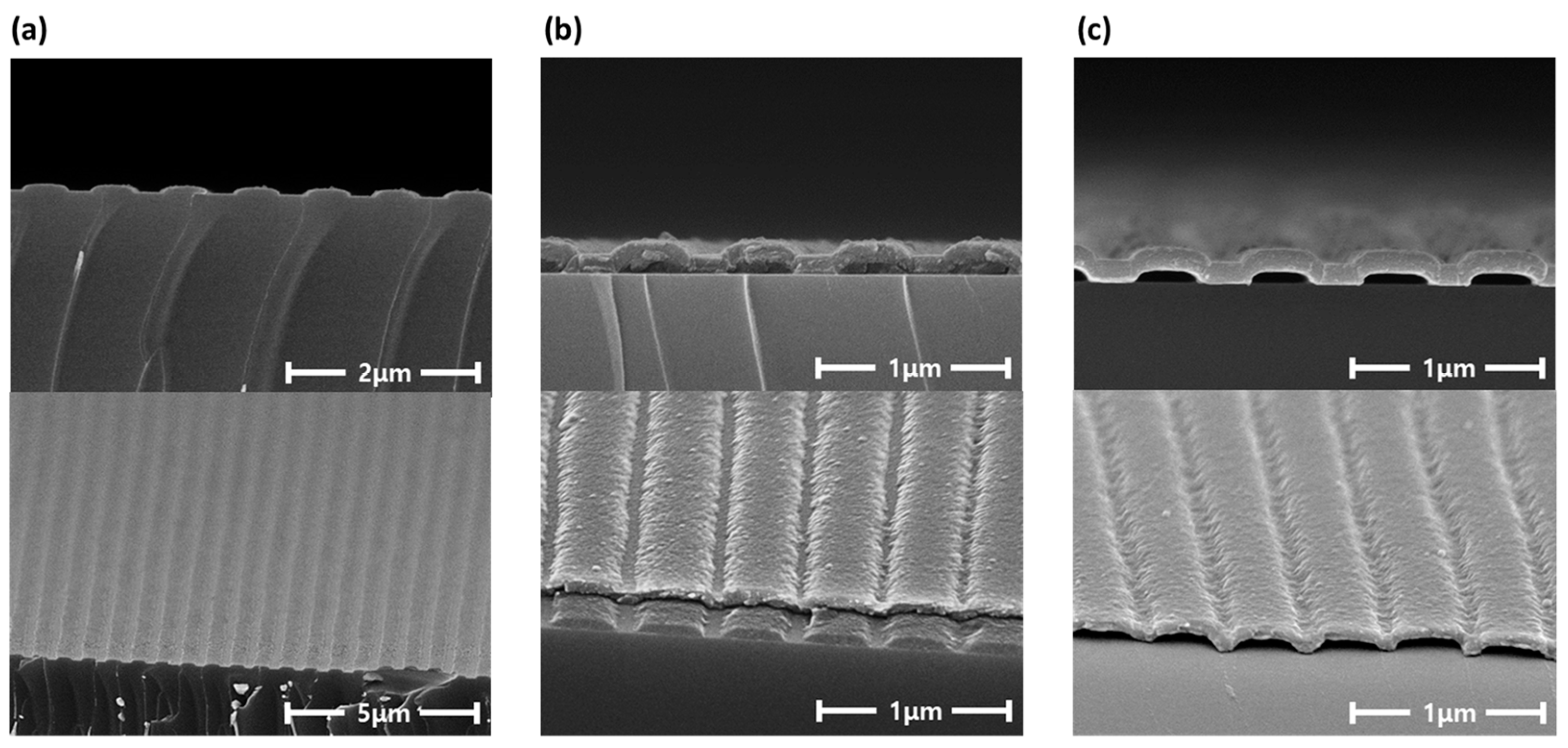
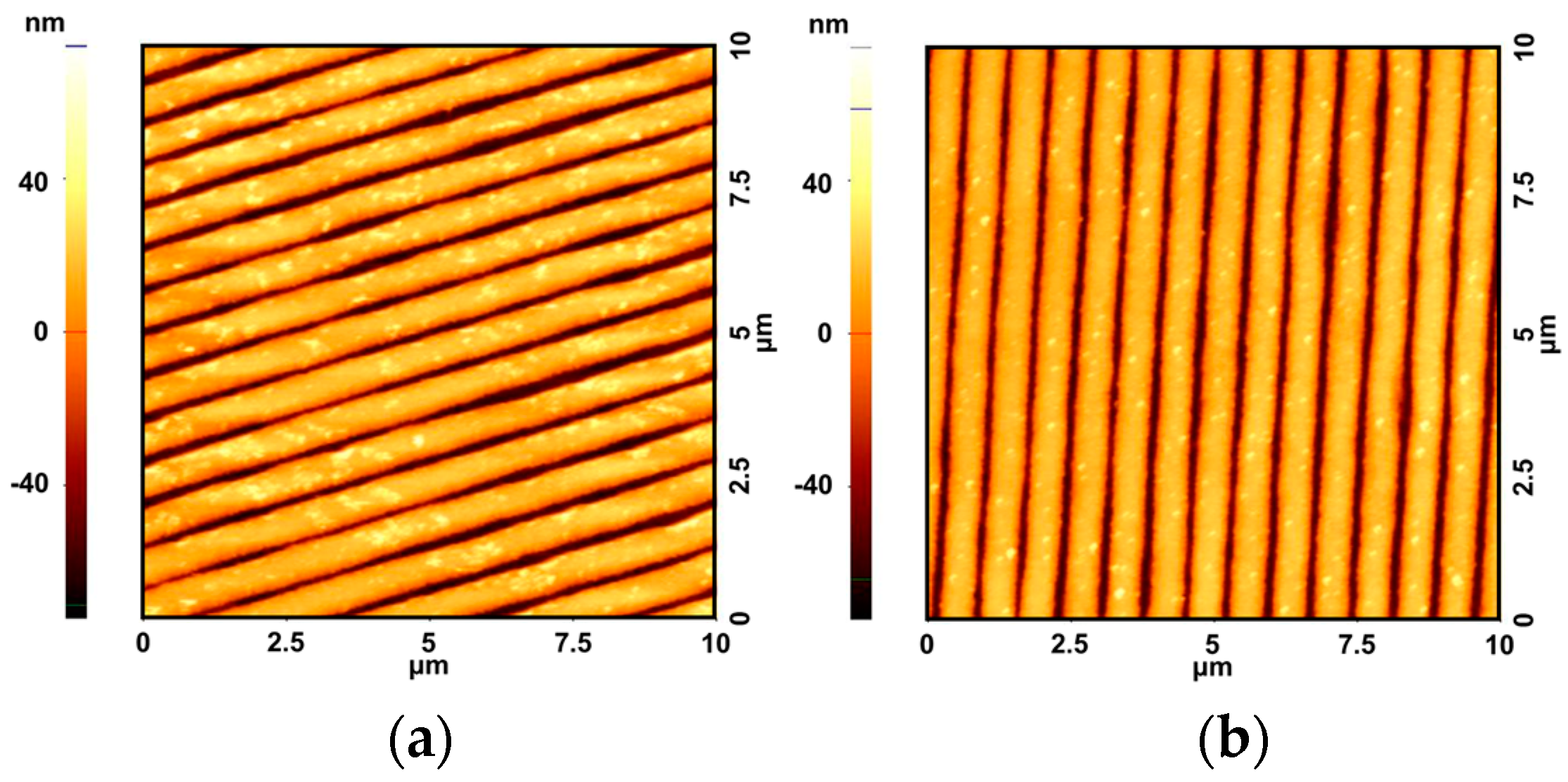


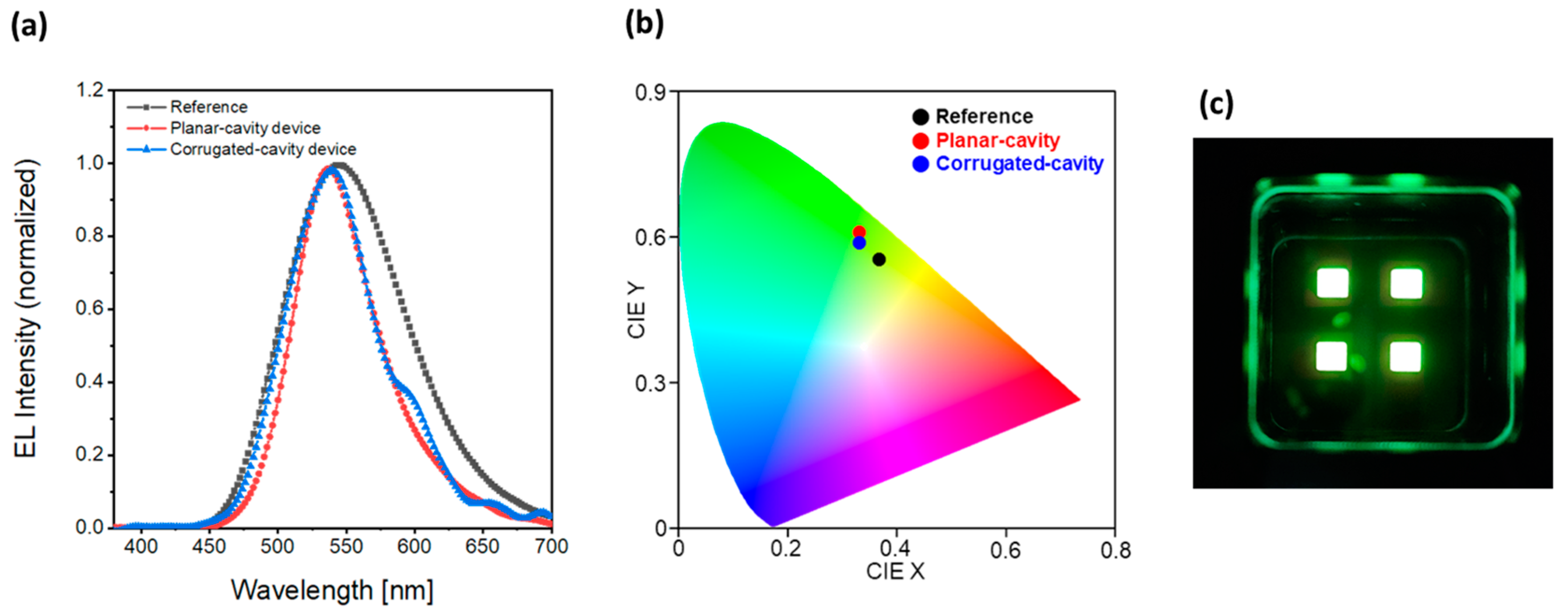
| Sample | Glass/nVPCL/Ag | Glass/nVPCL/Ag/IZO | Glass/Ag | Glass/Ag/IZO |
|---|---|---|---|---|
| Rq [nm] | 27.484 | 24.102 (−12.31%) (a) | 3.058 | 2.318 (−24.20%) (a) |
| Ra [nm] | 22.253 | 19.830 (−10.89%) (a) | 2.379 | 1.781 (−25.14%) (a) |
Disclaimer/Publisher’s Note: The statements, opinions and data contained in all publications are solely those of the individual author(s) and contributor(s) and not of MDPI and/or the editor(s). MDPI and/or the editor(s) disclaim responsibility for any injury to people or property resulting from any ideas, methods, instructions or products referred to in the content. |
© 2024 by the authors. Licensee MDPI, Basel, Switzerland. This article is an open access article distributed under the terms and conditions of the Creative Commons Attribution (CC BY) license (https://creativecommons.org/licenses/by/4.0/).
Share and Cite
Park, S.; Kang, B.; Lee, S.; Bi, J.C.; Park, J.; Hwang, Y.H.; Park, J.-Y.; Hwang, H.; Park, Y.W.; Ju, B.-K. Hollow Microcavity Electrode for Enhancing Light Extraction. Micromachines 2024, 15, 328. https://doi.org/10.3390/mi15030328
Park S, Kang B, Lee S, Bi JC, Park J, Hwang YH, Park J-Y, Hwang H, Park YW, Ju B-K. Hollow Microcavity Electrode for Enhancing Light Extraction. Micromachines. 2024; 15(3):328. https://doi.org/10.3390/mi15030328
Chicago/Turabian StylePark, Seonghyeon, Byeongwoo Kang, Seungwon Lee, Jian Cheng Bi, Jaewon Park, Young Hyun Hwang, Jun-Young Park, Ha Hwang, Young Wook Park, and Byeong-Kwon Ju. 2024. "Hollow Microcavity Electrode for Enhancing Light Extraction" Micromachines 15, no. 3: 328. https://doi.org/10.3390/mi15030328
APA StylePark, S., Kang, B., Lee, S., Bi, J. C., Park, J., Hwang, Y. H., Park, J.-Y., Hwang, H., Park, Y. W., & Ju, B.-K. (2024). Hollow Microcavity Electrode for Enhancing Light Extraction. Micromachines, 15(3), 328. https://doi.org/10.3390/mi15030328






